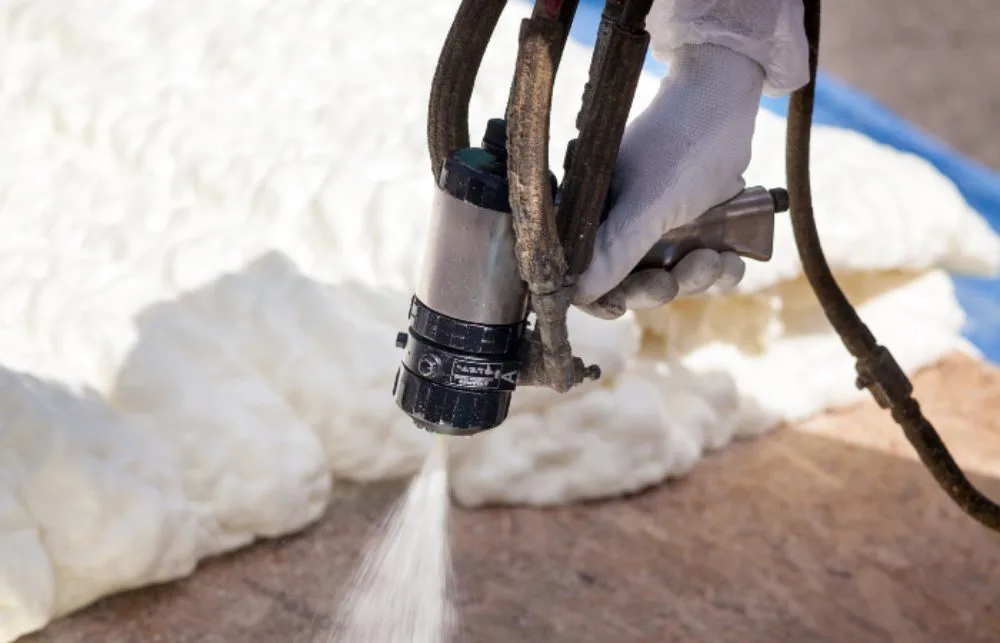Spray foam insulation is a popular method to keep buildings warm or cool efficiently. It’s applied as a liquid using a spray gun, and then it expands into a foam that fills gaps and cracks. It can have varying flammability depending on the type of foam. Open-cell spray foam is generally flammable, while closed-cell spray foam tends to be less flammable in comparison. The distinction arises from their composition, with closed-cell foam being denser and offering higher resistance.
Understanding the flammability of insulation materials is crucial as it directly affects both the safety and overall performance of a building. In this analysis, we will talk about the additional factors that can influence and is spray foam insulation flammable and how to ensure a safe installation process.
Industry Standards and Regulations
Maintaining the fire safety of insulation materials is essential through adherence to industry standards and regulations. Standardized fire testing procedures, such as those assessing flame spread, smoke development, and heat release, provide a consistent framework for evaluating how materials react to fire. The safety regulations set by authorities establish standards for aspects like the insulation’s ability to resist catching fire and the rate at which flames spread. Companies carefully test their insulation to make sure it meets these rules, showing it’s safe for people in buildings and getting approval from regulators.
Fire Resistance Properties
Spray foam insulation is flammable, but it has certain properties that make it fire retardant. It typically consists of two main components: polyol resin and isocyanate. Here are the composition and structure of spray foam insulation and how these components contribute to its fire resistance:
- Polyol Resin
Polyol resin is a liquid polymer containing multiple hydroxyl (-OH) groups derived from petrochemical sources or plant-based materials. When polyol resin reacts with isocyanate during the application of spray foam insulation, it forms a solid polyurethane foam structure. This foam, with its closed-cell nature, acts as a barrier that restricts the movement of air and minimizes the supply of oxygen to potential fires, contributing to fire resistance.
- Isocyanate
Isocyanate is a reactive chemical compound with isocyanate functional groups (N=C=O), commonly found in types like methylene diphenyl diisocyanate (MDI) or toluene diisocyanate (TDI). Isocyanate serves as a cross-linking agent in the chemical reaction with polyol that leads to the formation of a polyurethane foam structure. The resulting closed-cell foam provides a barrier that resists heat transfer, which contributes to the insulation’s ability to withstand high temperatures and enhance fire resistance.
- Blowing Agents
Some formulations include blowing agents, such as hydrofluorocarbons (HFCs) or hydrochlorofluorocarbons (HCFCs), which generate gas bubbles within the foam during the chemical reaction. Blowing agents contribute to the expansion of the foam and create a cellular structure that not only enhances insulation properties but also reduces the permeability of the material to flames. The closed-cell structure formed by blowing agents helps create a barrier that hinders the progress of fire.
- Flame Retardants
Flame retardants, like halogenated compounds or phosphorus-based additives, are often incorporated into spray foam insulation. These additives play a vital role in boosting fire resistance by slowing down or inhibiting the combustion process. Flame retardants can interrupt the chemical reactions involved in a fire, which reduces the likelihood and speed of flame spread within the insulation material.
Common Misconceptions
It’s important to emphasize the significance of proper installation, adherence to safety standards, and the diversity of spray foam formulations available. Here are some common misconceptions about spray foam insulation flammability:
- Spray Foam Insulation Is Highly Flammable
While it’s crucial to follow proper installation guidelines, cured and well-installed spray foam insulation is not highly flammable. Many formulations are designed with fire-retardant properties, and the material typically has a high ignition temperature.
- Spray Foam Insulation Releases Toxic Fumes in a Fire
Reputable spray foam manufacturers ensure their products undergo rigorous testing for fire safety. When properly installed, spray foam insulation releases minimal toxic fumes during a fire, and many formulations are designed to meet strict safety standards.
- Spray Foam Insulation Increases the Risk of Fire Spread
When installed correctly, spray foam insulation acts as a barrier that can decrease the risk of fire spread. Its application creates a seamless and airtight seal that limits the movement of air, which can contribute to fire containment.
- All Spray Foam Insulation is Equally Flammable
Various types of spray foam insulation exist, including open-cell and closed-cell foam. Closed-cell foam, being denser, generally has higher fire resistance compared to open-cell foam. It’s essential to choose the right type for specific applications.
- DIY Spray Foam Insulation Poses Greater Fire Risks
DIY spray foam insulation projects may indeed pose risks if not done correctly. Professional installation is crucial to ensuring proper curing and adherence to safety standards. Hiring certified installers minimizes the risk of flammability concerns.
- Spray Foam Insulation is Always a Fire Hazard in Attics
When installed according to building codes and safety guidelines, spray foam insulation can be safely used in attics. Proper ventilation and compliance with local regulations are key factors in mitigating any potential fire risks.
- Spray Foam Insulation Cannot Meet Building Code Fire Safety Requirements
Reputable spray foam insulation products are designed to meet or exceed building code requirements for fire safety. Compliance with these codes ensures that the insulation is safe for use in various construction applications.
- Spray Foam Insulation is Inherently Unsafe in High-Temperature Environments
While it’s essential to consider the specific conditions of use, spray foam insulation is formulated to withstand normal temperature fluctuations in buildings. It’s crucial to follow the manufacturer’s recommendations and choose the appropriate type of insulation for specific environments.
Best Practices for Spray Foam Installation
Proper installation techniques are essential in minimizing fire risks associated with insulation materials, such as spray foam. Accurate and careful installation helps ensure that the insulation functions as intended, which minimizes the likelihood of fire-related incidents. It’s also essential to strictly adhere to the specific guidelines provided by spray foam manufacturers.
These guidelines cover essential aspects such as mixing ratios, application temperatures, and curing times. Additionally, compliance with local building codes is a must, as these codes often include safety requirements for insulation materials.
Spray Foam Insulation Maintenance and Inspection

Regular inspections are crucial for keeping spray foam insulation effective and fire-resistant. Inspections should be conducted at regular intervals, ideally annually, to identify and address any possible issues that may compromise the insulation’s ability to resist fire. Recommendations for maintaining a safe environment with spray foam insulation include:
- Scheduled professional inspections
- Prompt issue resolution
- Educate people about safety
- Follow the manufacturer’s guidelines
- Keep good records of all checks and fixes
- Develop and communicate emergency plans
Is Spray Foam Insulation Flammable? FAQs
Is spray foam insulation a fire hazard?
No. Most types of foam insulation are flammable, but spray foam insulation is generally considered safe and has fire-resistant properties. Closed-cell spray foam, in particular, tends to be less permeable and can act as a barrier against flames. However, the flammability may vary depending on the specific formulation and installation.
Is there non-flammable spray foam?
While no insulation material is entirely non-flammable, certain types of spray foam, such as closed-cell foam, are known for their fire-resistant properties. Manufacturers often produce formulations with fire-retardant additives to enhance resistance. It is essential to note that complete non-flammability is challenging to achieve, and proper installation practices play a significant role in ensuring optimal fire resistance.
How do you fireproof spray foam insulation?
Choosing closed-cell foam, which tends to be more fire-resistant, is one approach. Additionally, using formulations with fire-retardant additives, following proper installation techniques, and ensuring compliance with local building codes contribute to fireproofing the insulation. It’s crucial to consult with professionals and adhere to industry guidelines for the best results.
Is spray foam more flammable than fiberglass?
Yes. Comparing the flammability of spray foam and fiberglass insulation depends on the specific type of spray foam used. Generally, closed-cell spray foam is known to be less flammable, while fiberglass is naturally not flammable. However, it’s essential to consider factors such as installation practices, building codes, and local regulations when evaluating the fire resistance of insulation materials.
How long is spray foam flammable?
The flammability of spray foam insulation can vary based on its formulation, installation, and environmental conditions. In normal circumstances, once spray foam is properly cured and installed, it is not continuously flammable. However, in the event of a fire, the insulation may contribute to combustion. It is crucial to observe safety guidelines, comply with building codes, and use fire-resistant formulations where necessary to minimize potential risks.
What is the disadvantage of spray foam insulation?
While spray foam insulation offers numerous benefits, including high thermal resistance and air-sealing properties, it does have some disadvantages. One primary drawback is the initial cost, which tends to be higher than traditional insulation materials. Improper installation can lead to issues, and not all formulations are suitable for every application. Additionally, some individuals may be sensitive to the chemicals used in spray foam, necessitating proper ventilation during and after installation.
Conclusion
Spray foam insulation serves as a popular and efficient solution for maintaining comfortable indoor temperatures. Understanding its flammability characteristics is essential for ensuring both safety and optimal performance in buildings. Thinking about how it’s made, putting it in correctly, and following safety rules, spray foam insulation can become a safe and effective choice for improving energy efficiency.
At Tropic-Air Conditioning Inc., we ensure the proper installation and adherence to safety guidelines that make spray foam insulation a smart choice for your home or business. Reach out to us today.




